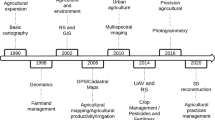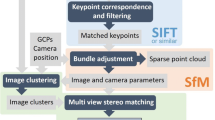Abstract
A typical topographic survey constructs and interpolates the undulating topographic surface of the earth. Although satellite and radar images with elevation information are a well-known method for topographic survey worldwide, due to the high cost, these sources are not popular enough, especially in developing countries. In contrast to that, unmanned aerial vehicle (UAV) could be a cost-effective and time-effective method for 3D in-depth mapping analysis. The broad aim of this study was to construct a Python-based mathematical model for 3D modeling using UAV imageries. For the purpose of this research work, primary data have been collected by DJI Mavic Pro with 1/2.3″ (CMOS) 12.71 M Effective pixels sensor and used secondary information from different published sources. DroneDeploy software was used for flight mission planning to collect the relevant imageries. Agisoft Metashape Professional software was used for geocorrection of the collected imageries, image alignment, dense cloud mapping, digital surface modeling, and development of orthomosaic imageries. QGIS software was used to develop a python-based mathematical model of digital terrain modeling (DTM), which could provide measurements at actual ground elevation. ArcGIS software was used for mapping and representation of the developed model and imageries.







Similar content being viewed by others
Data Availability
Data are available on request to the first or corresponding author.
References
Agrawal A, Radhakrishna M, Joshi RC (2006) Geometry-based mapping and rendering of vector data over LOD photo textured 3D terrain models
Balasubramanian A (2017) Digital elevation model (DEM) in GIS. University of Mysore, https://www.researchgate.net/publication/319454004_DIGITAL_ELEVATION_MODEL_DEM_IN_GIS
Dandois JP, Ellis EC (2013) High spatial resolution three-dimensional mapping of vegetation spectral dynamics using computer vision. Remote Sens Environ 136:259–276. https://doi.org/10.1016/j.rse.2013.04.005
Dunne J (2015) Using aerial photos to produce digital surface models, otrhophotos, and land cover maps of a coastal area in Puget Sound, WA (Doctoral dissertation).
Fonstad MA, Dietrich JT, Courville BC, Jensen JL, Carbonneau PE (2013) Topographic structure from motion: a new development in photogrammetric measurement. Earth Surf Proc Land 38(4):421–430. https://doi.org/10.1002/esp.3366
Haarbrink RB, Koers E (2006) Helicopter UAV for photogrammetry and rapid response. In International Archives of Photogrammetry, Remote Sensing and Spatial Information Sciences, ISPRS Workshop of Inter-Commission WG I/V, Autonomous Navigation, Antwerp, Belgium
INSPIRE Data Specification on Elevation (2013) Technical Guidelines Creator INSPIRE Thematic Working Group Elevation, European Commision Joint Research Centre, D2.8.II.1_v3.0 https://inspire.ec.europa.eu/documents/Data_Specifications/INSPIRE_DataSpecification_EL_v3.0.pdf
Jancso T, Melykuti G (2011) Comparison of digital terrain models gained by different technologies. In Proceedings 2011 IEEE International Conference on Spatial Data Mining and Geographical Knowledge Services (pp. 324–329). IEEE. https://doi.org/10.1109/ICSDM.2011.5969056
Juřík V, Herman L, Snopková D, Galang AJ, Stachoň Z, Chmelík J, Šašinka Č (2020) The 3D hype: evaluating the potential of real 3D visualisation in geo-related applications. Plos one 15(5):e0233353
Lane SN, James TD, Crowell MD (2000) Application of digital photogrammetry to complex topography for geomorphological research. Photogram Rec 16(95):793–821. https://doi.org/10.1111/0031-868X.00152
Leberl F, Thurgood J (2004) The promise of softcopy photogrammetry revisited. … Archives of the Photogrammetry, Remote Sensing …. Retrieved from http://www.isprs.org/proceedings/XXXV/congress/comm3/papers/370.pdf
Liu Z, Koyi HA, Swantesson JO, Nilfouroushan F, Reshetyuk Y (2013) Kinematics and 3-D internal deformation of granular slopes: analogue models and natural landslides. J Struct Geol 53:27–42
Nebiker S, Lack N, Deuber M (2014) Building change detection from historical aerial photographs using dense image matching and object-based image analysis. Remote Sensing 6(9):8310–8336. https://doi.org/10.3390/rs6098310
Nex F, Remondino F (2014) UAV for 3D mapping applications: a review. Applied Geomatics 6(1):1–15
Nocerino E, Menna F, Remondino F, Saleri R (2013) Accuracy and block deformation analysis in automatic UAV and terrestrial photogrammetry - lesson learnt. ISPRS Annals of the Photogrammetry, Remote Sensing and Spatial Information Sciences, Vol. II(5/W1), pp. 203–208
Pérez M, Agüera F, Carvajal F (2013) Low cost surveying using an unmanned aerial vehicle. Int Arch Photogramm Remote Sens Spat Inf Sci 40:311–315
Puri B (2007) U.S. patent application No. 10/585,026
Rabiu L, Waziri DA (2014) Digital orthophoto generation with aerial photographs. Academic Journal of Interdisciplinary Studies 3(7):133–133
Redhawk (2019) How is a topographic survey important?. topographical surveyors edmond, topographical survey. 405.923.0408. https://www.redhawksurveying.com/articles/how-is-a-topographical-survey-important
Remondino F, Barazzetti L, Nex F, Scaioni M, Sarazzi D (2011) UAV photogrammetry for mapping and 3d modeling–current status and future perspectives. International Archives of the Photogrammetry, Remote Sensing and Spatial Information Sciences 38(1):C22
Royo S, Ballesta-Garcia M (2019) An overview of lidar imaging systems for autonomous vehicles. Appl Sci 9(19):4093
Shahjahan M, Aziz MA (2017) A text book of surveying. University Campus Printing Press, Dhaka, Bangladesh, pp 978-984-92173-0–5
Singh RL, Singh RPB (2002) Elements of practical geography. Kalyani Publishers, New Delhi, India, pp 81-7096-910–7
Xie K, Yang J, Zhu YM (2008) Real-time visualisation of large volume datasets on standard PC hardware. Comput Methods Programs Biomed 90(2):117–123
Funding
This research paper was written without funding which was inspired and supported by the first co-author.
Author information
Authors and Affiliations
Corresponding author
Ethics declarations
Ethics Approval
The Spatial Analysis Lab approved this research in Jahangirnagar University, Bangladesh. All of the analyses were performed in studies involving such inspiration for the apprentice’s researcher to develop various kinds of models for further research using unmanned aerial vehicles.
Conflict of Interest
The authors declare no competing interests.
Additional information
Publisher's Note
Springer Nature remains neutral with regard to jurisdictional claims in published maps and institutional affiliations.
Rights and permissions
About this article
Cite this article
Ahmed, R., Mahmud, K.H. & Tuya, J.H. A GIS-Based Mathematical Approach for Generating 3D Terrain Model from High-Resolution UAV Imageries. J geovis spat anal 5, 24 (2021). https://doi.org/10.1007/s41651-021-00094-7
Accepted:
Published:
DOI: https://doi.org/10.1007/s41651-021-00094-7




